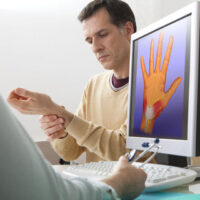Workers’ Compensation For Repetitive Strain Injuries

Repetitive strain injuries are a growing concern for workers across Maryland. These injuries develop over time due to repetitive motions, poor posture, or consistent overuse of certain body parts. They can result in long-term pain and disability.
Many workers mistakenly assume that workers’ compensation only applies to sudden accidents or traumatic injuries, but workers who suffer from strain injuries can also file for benefits. Connect with a Baltimore personal injury lawyer to explore your options.
Common Repetitive Strain Injuries
Some of the most common repetitive strain injuries that affect workers in Maryland include:
- Carpal tunnel. Perhaps the most well-known repetitive strain injury, carpal tunnel occurs when the median nerve in the wrist becomes compressed due to repetitive wrist movements, such as typing, using a mouse, or working on an assembly line. Symptoms include numbness, tingling, and weakness in the hand and wrist, which can become debilitating over time.
- Tendinitis refers to inflammation of the tendons caused by repetitive motion. Common areas affected include the shoulders, elbows, and knees. In the case of workers, tendinitis may result from constant lifting, reaching, or repetitive tasks that put strain on specific joints.
- Back pain and strain. While back injuries can occur suddenly, many cases of chronic back pain stem from repetitive movements such as lifting, bending, or twisting on a regular basis. This can be especially prevalent in jobs that require heavy lifting or long periods of sitting, such as truck driving or office work.
- Rotator cuff injuries. The rotator cuff, a group of muscles and tendons in the shoulder, can be damaged due to repetitive overhead motions, such as lifting, reaching, or throwing. Workers in fields like construction, manufacturing, and healthcare are particularly vulnerable to these types of injuries.
One of the biggest challenges workers face when filing a workers’ compensation claim for a strain injury is proving that the harm is work-related. Unlike traumatic injuries, which have an immediate cause, these injuries develop gradually over time, making them harder to link to a specific work task.
Documented Symptoms and Medical Review
It’s essential to seek medical attention as soon as symptoms arise. A doctor’s diagnosis, which links the injury to your work activities, is crucial. Your healthcare provider may ask about your job duties and assess whether repetitive motions or overuse of certain body parts could have caused or contributed to your injury.
To strengthen your claim, you should gather evidence that supports your assertion that your work conditions led to the injury. This could include job descriptions, records of repetitive tasks, or testimony from coworkers who perform similar duties. If you’ve reported symptoms to your employer, this documentation can also be helpful in establishing a timeline.
A Baltimore personal injury lawyer can gather evidence related to your work environment as well. With legal support, you can pursue compensation for your injuries and ensure that you receive the medical care you need to recover.
Do you need monetary funds to manage expenses connected to work-induced harm? The legal team at Iamele & Iamele, LLP are available to help. Contact us to book your confidential appointment.

